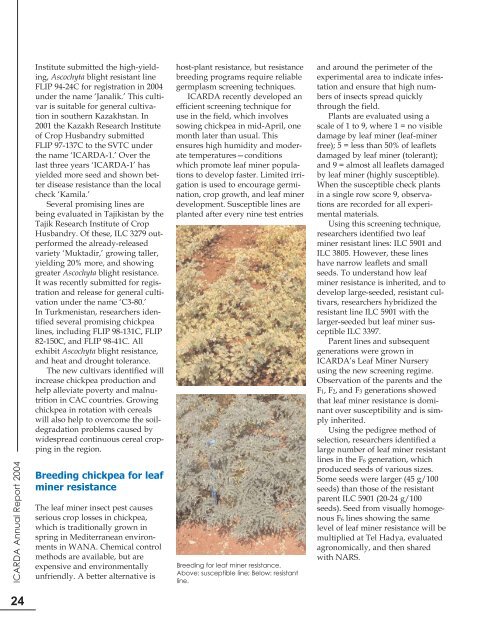ICARDA annual report 2004
ICARDA annual report 2004
ICARDA annual report 2004
You also want an ePaper? Increase the reach of your titles
YUMPU automatically turns print PDFs into web optimized ePapers that Google loves.
<strong>ICARDA</strong> Annual Report <strong>2004</strong><br />
24<br />
Institute submitted the high-yielding,<br />
Ascochyta blight resistant line<br />
FLIP 94-24C for registration in <strong>2004</strong><br />
under the name ‘Janalik.’ This cultivar<br />
is suitable for general cultivation<br />
in southern Kazakhstan. In<br />
2001 the Kazakh Research Institute<br />
of Crop Husbandry submitted<br />
FLIP 97-137C to the SVTC under<br />
the name ‘<strong>ICARDA</strong>-1.’ Over the<br />
last three years ‘<strong>ICARDA</strong>-1’ has<br />
yielded more seed and shown better<br />
disease resistance than the local<br />
check ‘Kamila.’<br />
Several promising lines are<br />
being evaluated in Tajikistan by the<br />
Tajik Research Institute of Crop<br />
Husbandry. Of these, ILC 3279 outperformed<br />
the already-released<br />
variety ‘Muktadir,’ growing taller,<br />
yielding 20% more, and showing<br />
greater Ascochyta blight resistance.<br />
It was recently submitted for registration<br />
and release for general cultivation<br />
under the name ‘C3-80.’<br />
In Turkmenistan, researchers identified<br />
several promising chickpea<br />
lines, including FLIP 98-131C, FLIP<br />
82-150C, and FLIP 98-41C. All<br />
exhibit Ascochyta blight resistance,<br />
and heat and drought tolerance.<br />
The new cultivars identified will<br />
increase chickpea production and<br />
help alleviate poverty and malnutrition<br />
in CAC countries. Growing<br />
chickpea in rotation with cereals<br />
will also help to overcome the soildegradation<br />
problems caused by<br />
widespread continuous cereal cropping<br />
in the region.<br />
Breeding chickpea for leaf<br />
miner resistance<br />
The leaf miner insect pest causes<br />
serious crop losses in chickpea,<br />
which is traditionally grown in<br />
spring in Mediterranean environments<br />
in WANA. Chemical control<br />
methods are available, but are<br />
expensive and environmentally<br />
unfriendly. A better alternative is<br />
host-plant resistance, but resistance<br />
breeding programs require reliable<br />
germplasm screening techniques.<br />
<strong>ICARDA</strong> recently developed an<br />
efficient screening technique for<br />
use in the field, which involves<br />
sowing chickpea in mid-April, one<br />
month later than usual. This<br />
ensures high humidity and moderate<br />
temperatures—conditions<br />
which promote leaf miner populations<br />
to develop faster. Limited irrigation<br />
is used to encourage germination,<br />
crop growth, and leaf miner<br />
development. Susceptible lines are<br />
planted after every nine test entries<br />
Breeding for leaf miner resistance.<br />
Above: susceptible line; Below: resistant<br />
line.<br />
and around the perimeter of the<br />
experimental area to indicate infestation<br />
and ensure that high numbers<br />
of insects spread quickly<br />
through the field.<br />
Plants are evaluated using a<br />
scale of 1 to 9, where 1 = no visible<br />
damage by leaf miner (leaf-miner<br />
free); 5 = less than 50% of leaflets<br />
damaged by leaf miner (tolerant);<br />
and 9 = almost all leaflets damaged<br />
by leaf miner (highly susceptible).<br />
When the susceptible check plants<br />
in a single row score 9, observations<br />
are recorded for all experimental<br />
materials.<br />
Using this screening technique,<br />
researchers identified two leaf<br />
miner resistant lines: ILC 5901 and<br />
ILC 3805. However, these lines<br />
have narrow leaflets and small<br />
seeds. To understand how leaf<br />
miner resistance is inherited, and to<br />
develop large-seeded, resistant cultivars,<br />
researchers hybridized the<br />
resistant line ILC 5901 with the<br />
larger-seeded but leaf miner susceptible<br />
ILC 3397.<br />
Parent lines and subsequent<br />
generations were grown in<br />
<strong>ICARDA</strong>’s Leaf Miner Nursery<br />
using the new screening regime.<br />
Observation of the parents and the<br />
F1, F2, and F3 generations showed<br />
that leaf miner resistance is dominant<br />
over susceptibility and is simply<br />
inherited.<br />
Using the pedigree method of<br />
selection, researchers identified a<br />
large number of leaf miner resistant<br />
lines in the F6 generation, which<br />
produced seeds of various sizes.<br />
Some seeds were larger (45 g/100<br />
seeds) than those of the resistant<br />
parent ILC 5901 (20-24 g/100<br />
seeds). Seed from visually homogenous<br />
F6 lines showing the same<br />
level of leaf miner resistance will be<br />
multiplied at Tel Hadya, evaluated<br />
agronomically, and then shared<br />
with NARS.



